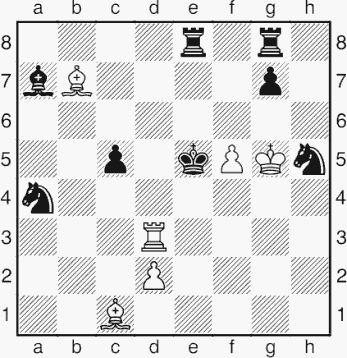
I have decided not to investigate chess problems (such as “White to play and mate in 3”) in depth in this book, feeling the subject is too specialized, and that to do it justice would require a detailed coverage. However, here is a position from the grey area between studies and problems.
A. Lobusov
“Vecherny Kharkov” 1985

The task here is White to play and force mate in 16 moves! Unbelievable? Here’s the solution:
1 Rd5+ Ke4 2 Rd7+ Ke5 3 Ba3
The threat is 4 d4+ cxd4 5 Bd6#.
3...c4
3...Re6 4 d4+ cxd4 5 Bd6+ Rxd6 6 Re7+ Re6 7 Rxe6#.
4 Bd6+ Kd4 5 Bf8+ Ke5 6 Rd5+ Ke4
We are now almost back where we started, except that White’s bishop has moved from c1 to f8, and the pawn is now on c4.
7 Rd8+ Ke5 8 Rxe8+ Kd4 9 Rd8+ Ke5 10 Rd5+ Ke4 11 Rd7+
The rook needs to be able to give a check on the e-file after the bishop has moved from f8.
11...Ke5 12 Bd6+ Kd4 13 Bb4+ Ke5 14 d4+ cxd3
14...Bxd4 15 Bd6#.
15 Re7+ Kd4 16 Re4#
If you have enjoyed these positions, I recommend that you consult some of the specialist literature and periodicals on studies and problems.
On the next two pages are a couple of chess problems, both “White to play and force checkmate in two moves”. They were the mates-in-two in the 5th International Solving Contest (ISC), held globally on 25th January 2009. They are rather difficult, so don’t feel obliged to try to solve them!